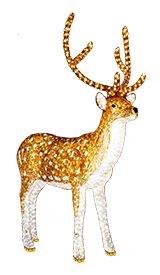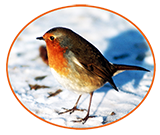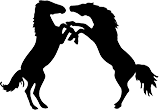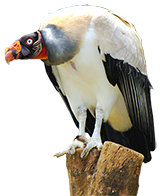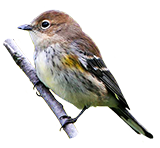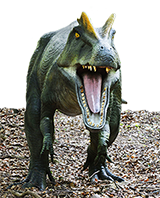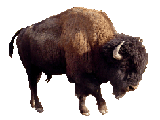Fascinating Animal Facts
This is the main page for interesting facts about animals, where you can read about animal intelligence, animal instinct, behavior, endangered animals, dangerous animals and a lot more.
This page of animal facts is an introduction to the fascinating
world of animals as well as an overview of all the animal fact
pages.
When you look at the animal world, it's amazing
how many different shapes, colors sizes and types of life there are
on our planet. There are more different types of animals living in
unusual landscapes all across the globe than most of us can really
imagine, from the jungles of South America to the depths of the
Pacific Ocean.
Kids are often fascinated by animals, especially the exotic animals often seen in zoos like gorillas, elephants and tigers.
When you need clip art of animals, chances are you're also going to need facts
to go with the pictures. That's what these pages are here for – even though this
is a clip art website, all these facts are accurate and well-researched.
You can
use the information here for school projects or any writing that requires lots
of information about animals. Here you'll find elephants facts, dolphin facts,
owl facts, facts about sharks, eagle facts and a whole range of other animal
facts.
12 Random Animal Facts
Here's an assortment of facts about various animals that may
surprise you:
#1: Sharks are fish, but
dolphins and whales are mammals
#2: The largest
flightless bird is the ostrich (it's also the fastest bird on land)
#3: Anacondas swallow their prey whole – and they
can dislocate their jaw to do it!
#4:
The
albatross claims the record for the widest wingspan at 11 feet
(around 3 and a half meters)
#5: Cats sleep
between 16 and 18 hours a day on average
#6: Pigs
get sunburned easily
#7: Armadillos can walk
underwater
#8: Giraffes
are the tallest living animals
#9: The first animal to visit outer space was a dog
#10: Cheetahs are the fastest mammals on land, with
a top speed of around 70 miles per hour (about 115 kilometers per
hour)
#11: There are roughly one million
different species identified living on Earth today. It's estimated
there may be another 4-14 million species that are yet to be
identified by scientists.
#12: Over 99% of all
species that have ever lived on Earth are now extinct
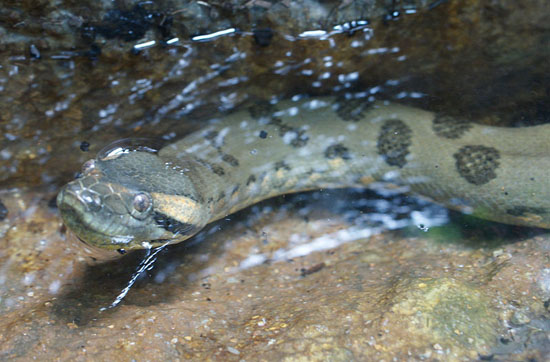
Animal Instincts
Few animals have the ability to make real, intelligent choices the way humans do.
Most of the time animals are just reacting to what's going on around them based on their emotions. All animals have a few basic instincts in common – the urge to eat, the urge to stay alive and the urge to reproduce (in other words, have babies).
But there are a few animals that have more advanced brains which
have allowed them to go beyond purely acting from instinct.
Amongst
these animals are the elephants and the dolphins. Both these
creatures have very complex social structures and are capable of
tasks that require a huge amount of intelligence.
Animal Intelligence
Animal intelligence has been studied widely.
It turns out that many
of the abilities we used to think separated humans from the rest of
the animal kingdom can also be found in animal species.
For example,
elephants can be trained to paint a picture of an elephant – they
are not only able to recognize their own species, they can also
create a picture of it.
When scientists look what facts about animals show animal intelligence, they look at a number of different abilities. There's not just one way to measure intelligence – it's made up of various brain functions, like memory, attention, the ability to use tools, communication, and the ability to solve problems.
 The two groups of animals scientists rate as having the highest
intelligence levels are the primates (which
includes chimpanzees, monkeys, gorillas and human beings) and the
cetaceans (which
includes dolphins and whales).
The two groups of animals scientists rate as having the highest
intelligence levels are the primates (which
includes chimpanzees, monkeys, gorillas and human beings) and the
cetaceans (which
includes dolphins and whales).
The human brain actually has a lot
more in common with a dolphin brain than it does with some species
of monkey!
One way scientists study intelligence in animals is by using
mathematics tests.
It's been discovered that both rhesus monkeys and
elephants are capable of counting and doing basic sums. Chimpanzees
have also been found to have a talent for numbers (which is not a
surprise, since chimps are the animals most closely related to
humans genetically).
But intelligence doesn't seem to be all about
brain size – even ants have been found to have some ability to
count. Ants and bees are quite interesting in this respect, because
they seem to have a 'hive intelligence' which allows them to work
together as a group in harmony.
It's hard to give animals a 'ranking' in terms of smartest to dumbest simply because of all these elements that go into making up what we call 'intelligence.'
Corvids, for example – a type of bird –
are quite capable of using tools, but they don't perform anywhere
near as well as elephants when it comes to things like memory and
counting.
Bonobo apes and chimpanzees seem to perform the best when
it comes to experiments on language use in animals.
Chimps are
capable of having conversations with humans through fairly complex
sign language, and Bonobos have even been able to write.
Facts about Dangerous Animals
Of course, not all animals are cute and cuddly. Many animals are
natural predators of humans.
Humans, as you may know, are related to
the apes – and before we developed the ability to use tools and
weapons, humans were very vulnerable to big predators like lions,
tigers and wolves.
What eventually saved humans was our big brains –
we got smart enough to start building houses and making weapons to
protect ourselves.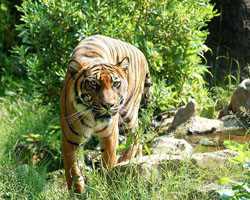
Still, there are lots of animals you wouldn't want to get stuck alone in a cage with.
Amongst the most dangerous animals to humans
are lions, tigers, leopards, bears, and sharks.
But there are other
animals you might not usually think of as being dangerous – such as
chimpanzees – which can do a great deal of damage to a person in the
wrong situation.
Of course, there are also small poisonous animals
like snakes and frogs which can harm people, and even tiny insects
like spiders and mosquitoes can harm people.
In fact, mosquitoes are
often called the most dangerous animals on Earth because of the way
they spread diseases like malaria. And the poison dart frog
of South
America carries one of the most deadly natural toxins known to man.
The box jellyfish is one of the most deadly marine creatures in the
world.
But there are many other dangerous animals that we often don't think of, because many of them aren't predators that would normally attack humans.
For example, a buffalo only eats plants but they can be very dangerous to humans in the wrong situation. Animals like buffalo, elephants, and giraffes can all be extremely dangerous if they are put in a position where they feel like humans are threatening them.
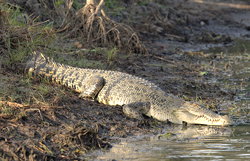 Also on the list of very dangerous animals are
polar bears and
saltwater crocodiles. Crocodiles are particularly dangerous
because they're so hard to spot when they're in the water.
Also on the list of very dangerous animals are
polar bears and
saltwater crocodiles. Crocodiles are particularly dangerous
because they're so hard to spot when they're in the water.
However, it's worth remembering one of the most
important facts about animals:
The most dangerous
animal in the world is humans. Because we are at the 'top of
the food chain,' humans are capable of eating virtually any
other animal in the world.
Our use of technology has made us
dangerous to many species of animal which otherwise would be a
danger to us, like the tigers.
Humans are a threat not just to
the animals we eat – human activity like logging and
overfishing has led to declining numbers of many types of
animals.
Humans have already been responsible for many
extinctions (when there are no animals of a particular species
left alive).
Arctic Animals
The Arctic (top of the world) and Antarctic (bottom of the
world) are some of the most difficult regions for animals to
survive in because of the incredibly low temperatures.
Still,
an amazing variety of creatures have managed to adapt to
living in these harsh conditions - it's not all just
polar
bears and penguins.
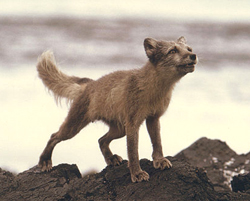 The
Arctic fox is one of the unique creatures to be found in
the Arctic.
The
Arctic fox is one of the unique creatures to be found in
the Arctic.
These foxes stand not much more than 10 inches
tall at the shoulder (about 25 centimeters).
They are
completely white to blend in with the snow, so their prey
can't see them when they hunt (although some have a blue tinge
to their fur, the color of Arctic ice).
When the summer comes,
they lose their warm white coat and it's replaced by light
brown fur so they can continue to blend in with the warmer
snow-free surroundings. The mainly hunt small animals such as
lemmings and some birds.
The walrus is one of the most unique and impressive of the
Arctic animals.
They look similar to elephant seals in terms
of their body shape, but the most distinguishing feature of
the walrus is their long tusks which point straight down.
A
male walrus is called a bull and can grow up to 12 feet long
(3.6 meters) and weigh 2 tons (about 4400 pounds).
In the Antarctic, the variety of animals is a lot more limited
because Antarctica does not join up to any other continents.
Unlike the Arctic, where large areas are snow-free during the
summer, the entire Antarctic is mostly covered in snow and ice
all year round.
That means land animals can't migrate to
warmer areas when they need to. As a result, the Antarctic is
populated mainly by sea life and by animals that can both swim
long distances and live on land, like penguins and
sea lions.
Endangered Animals and Rare Animals
There are many species in the world today which are classed as
endangered or threatened.
There are many reasons for this.
While species have always gone extinct because of natural
changes in the environment, a large number of the extinctions
that are happening today are the direct result of human
activities.
Many things we do endanger other animals,
including things like hunting and fishing too much and
polluting the environment.
Recently, the biggest concern for
endangered species has been climate change caused by humans.
Human activity is changing temperatures around the world which
can have severe effects on some species and the food chains
that depend on them.
Sometimes animals become endangered because humans introduce
new animals into an area which puts the ecosystem (the food
chain) out of balance.
The kiwi is one such endangered animal.
It's a flightless bird native to New Zealand.
Before the
arrival of humans in New Zealand, the kiwi – and the many
other flightless birds in that country – had no natural
predators. They lost the need to fly over many years because
there was nothing to fly away from.
Unfortunately, when humans
arrived they brought with them all kinds of predators – cats,
dogs, pigs and ferrets, for instance.
The kiwi has little
chance of escaping from one of these predators, which is why
this bird is now seriously at risk.
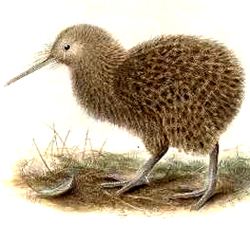
The way a food chain works means that even species that don't seem 'important' can have a big impact if they disappear.
There really is a 'circle of life' in nature where nothing is wasted – in an ecosystem, each species depends on each other species playing its role in order for the system to stay in balance.
As a result, taking away one species from the
ecosystem can have knock-on effects for every other species.
If a bear relies on a particular type of fish to survive and
the fish dies out because of river pollution, the bear will
then be in danger as well because it has lost a food source.
One of the most endangered animals in Europe is the Iberian
lynx.
A lynx is a type of wild cat. The Iberian lynx
population dropped as low as 60 in 2002, but it is now
increasing again slowly thanks to conservation work and
captive breeding programs.
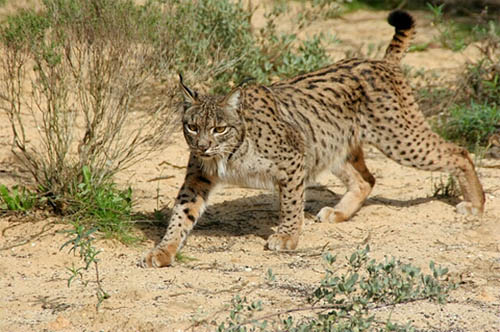
The sea otter is another endangered species, although the sea
otter's story is somewhat happier than that of many other
endangered animals.
The sea otter came close to extinction in
the early 1900s after many decades of being hunted for its
fur. At its lowest level the population is thought to have
dropped to around 1000 otters.
But after the hunting of these
animals was banned, the population has recovered somewhat on
its own. However, they are still protected and still classed
as endangered.
![]()
Facts about Animals like Dinosaur Facts (And Other Extinct Animals)
Although they largely disappeared from the Earth around 65 million years ago, dinosaurs are still a source of fascination to young and old alike.
Did you know there are still some creatures alive today that
are considered living dinosaurs?
The tuatara of New Zealand
is
a creature which has barely changed for millions of years and
looks like a mini-dinosaur.
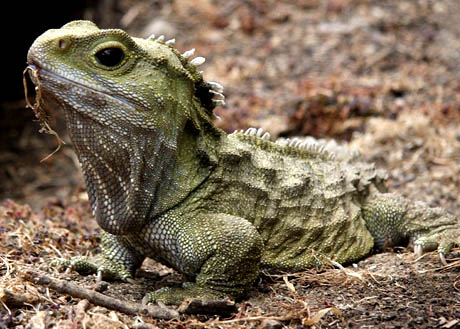
The movies have given us an idea of dinosaurs being huge
creatures, like the T-rex and the diplodocus.
While these
creatures where some of the largest ever to roam the Earth,
the average dinosaur was only about the size of a chicken!
The largest dinosaur fossil found to date was the
Argentinosauras, which from head to tail was about 120 feet
long (36 meters).
There may have been dinosaurs even larger
than this, although scientists have been yet to find any
larger complete fossils.
The largest meat-eating dinosaur was
not the T-Rex but was in fact theSpinosauras, which is
believed to have weighed up to 8 tons – making it tiny in
comparison to the blue whales that swim through our oceans
today, which weigh up to 180 metric tons.
Another big predator from the distant past that few people
have heard of is Megalodon, the biggest shark that ever
existed.
Megalodon may have been over 60 feet long (18.2
meters) and had teeth 7 inches long (about 18 centimeters),
making the great white shark of today look like a dwarf by
comparison.
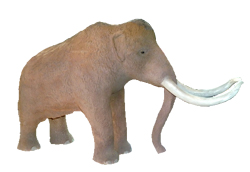 In more recent times there have been extinctions of some other
fantastic creatures that walked the Earth at the same time as
humans.
In more recent times there have been extinctions of some other
fantastic creatures that walked the Earth at the same time as
humans.
Amongst these extinct animals were the Moa bird and the
Woolly mammoth.
The giant Moa was one of the largest flightless birds of all
time, standing up to 12 feet (3.7 meters) tall. (Ostriches,
which are the largest living flightless bird today, only reach
around 9 feet tall). The Woolly mammoth was a type of
fur-covered elephant with giant tusks.
Most of the mammoths
disappeared during the last ice Age about 10,000 years ago,
although the last of them died off about 4,000 years ago.
![]()

I hope you have enjoyed this page with facts about animals, and that you have learned something you didn't know before !
| site search by freefind |
Hot pages right now:
Free Christmas borders
Free Christmas Clipart
Christmas Tree Clipart
Christmas Silhouettes
Christmas Clipart
Christmas Coloring Pages
Christmas Cards
Winter Clipart
Fall Clipart

Umbrella Clipart
Snowman Clipart
Horse silhouettes
Victorian Silhouette
Bird Pictures
Space clip art
Koi Fish Drawings
Penguin clip art
Butterfly Clipart
Dinosaur Clip Art
Animal clip art
Tiger Clipart







